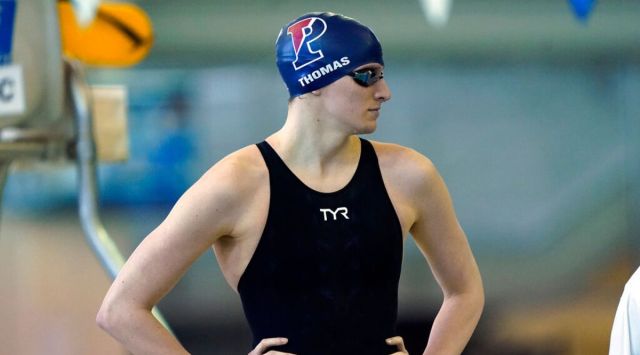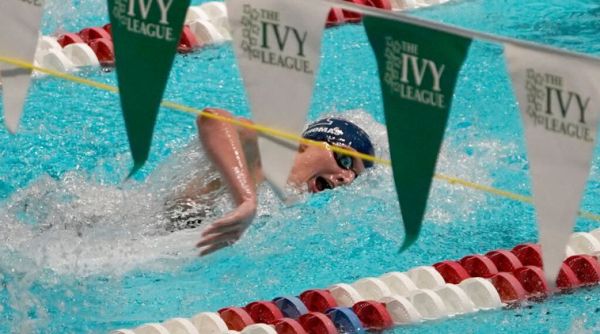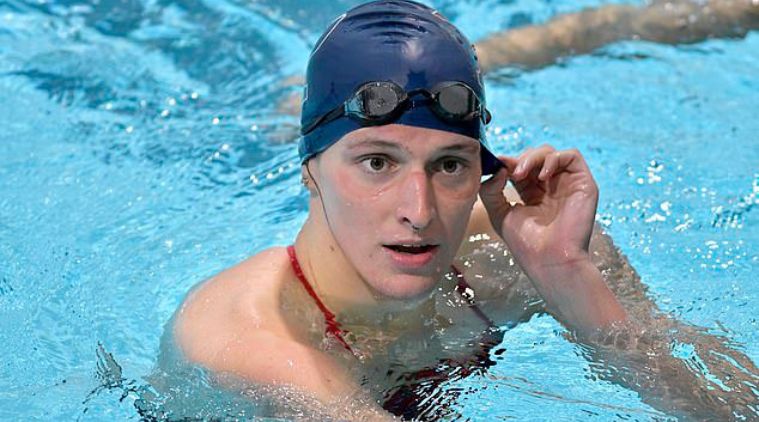- India
- International
Female, male and ‘Open’: FINA bars participation of transgenders in the women’s category
FINA voted against allowing transgender athletes to participate in female competitions – the exception being that the transgender athlete must have completed their transition before the age of 12.
 One could say Lia Thomas was the reason the world body of swimming took this measure. Thomas earlier competed in the male category in swimming for Penn State University and was part of their team for three years. (AP)
One could say Lia Thomas was the reason the world body of swimming took this measure. Thomas earlier competed in the male category in swimming for Penn State University and was part of their team for three years. (AP)Swimming’s international governing body FINA barred participation of transgenders in the women’s category in a controversial ruling on Monday, with Athletics and Football set to follow. Shashank Nair delves into the complex issue of how FINA are thinking of introducing an ‘Open’ category to include trans-women
The International Swimming Federation (FINA) voted against allowing transgender athletes to participate in female competitions – the exception being that the transgender athlete must have completed their transition before the age of 12.
The policy was voted upon by 274 members with 196 casting their votes in favour of it. The ruling only applies to elite competitions run by FINA. Athletics and FIFA were reported by BBC and British media, as two other major sporting bodies set to follow swimming’s cue.
FINA President Husain Al-Musallam announced that a Working Group was being set up to create an ‘open category’ in some FINA competitions. On the ‘open category’ Musallam said, “The creation of an open category will mean that everybody has the opportunity to compete at an elite level.” He then added, “This has not been done before, so FINA will need to lead the way.”
Track and Field’s IAAF boss Seb Coe later told BBC: “We see an international federation asserting its primacy in setting rules, regulations and policies that are in the best interest of its sport.

 Pennsylvania transgender swimmer Lia Thomas swims in the first leg of the 800-yard freestyle relay at the Ivy League women’s swimming and diving championships at Harvard, Wednesday, Feb. 16, 2022, in Cambridge, Mass. (AP File)
Pennsylvania transgender swimmer Lia Thomas swims in the first leg of the 800-yard freestyle relay at the Ivy League women’s swimming and diving championships at Harvard, Wednesday, Feb. 16, 2022, in Cambridge, Mass. (AP File)
This is as it should be. We have always believed that biology trumps gender and we will continue to review our regulations in line with this. We will follow the science.”
The move was also widely criticized by gender activists, on grounds of exclusion.
Why have these changes been made?
Transgender athletes in sports, particularly transgender women participating in women’s competitions, are at the heart of this change. A transgender woman who has gone through male puberty and then later on transitioned into a female, has been shown in case studies to retain testosterone levels that lead to higher structural advantages in sport over cisgender (A person whose sense of identity and gender corresponds with their birth sex) women.
Ross Tucker, a sports scientist explained on his podcast, the Real Science of Sport that the effects of testosterone result in the development of a body post puberty differently for men and women. He said that according to at least 13 case studies, men who later transitioned to becoming women do not have the effects of testosterone completely removed because they transitioned to become a woman.
“In a number of physiological systems that are relevant to performance – muscle mass, muscle strength, body performance, body fat, heart and lung size – testosterone creates things that are never fully undone,” said PHD Tucker on the Real Science of Sport podcast. He then added, “The difference between men and women for power, strength and muscle mass can be 30-40%. Testosterone suppression for a year can take away 5-10%. The result is quite a large retained advantage – and if you’ve retained biological advantage, then you’ve retained performance advantage.”
What is the stance of the IOC and other major sport bodies?
It is the importance given to testosterone and the timing of when it affects a human body, that has divided world bodies to the extent that the International Olympic Committee and the International Swimming Federation have almost opposite policies on transgender athletes.
For example, World Athletics has said that once transgender women reduce testosterone for 12 months, they should be allowed to compete in competition. USA Swimming dictates that trans athletes must undergo three years of hormone replacement therapy before they can be allowed to compete.
The IOC’s trans-trans-inclusion framework essentially gave the right to the leading bodies of sport to decide how they would incorporate their transgender athletes. It also said that sport bodies shouldn’t automatically assume that trans women athletes were inherently more advantaged than cisgender women athletes nor that transgender women shouldn’t have to reduce their testosterone levels to compete.
FINA in their Extraordinary Congress called upon their medical, legal and athlete counsels to speak. Each counsel had a couple of delegates who spoke on why FINA came to the decision. And then the member organisations voted for this historic measure.
 In March, Lia Thomas told Sports Illustrated: “The very simple answer is that I’m not a man. I’m a woman, so I belong on the women’s team. Trans people deserve that same respect every other athlete gets.” (Twitter)
In March, Lia Thomas told Sports Illustrated: “The very simple answer is that I’m not a man. I’m a woman, so I belong on the women’s team. Trans people deserve that same respect every other athlete gets.” (Twitter)
Why is Lia Thomas so important to this ruling?
One could say Lia Thomas was the reason the world body of swimming took this measure. Thomas earlier competed in the male category in swimming for Penn State University and was part of their team for three years. In 2019, she started undergoing hormone replacement therapy as per NCAA and Ivy League rules.
In 2022, after two years and six months of the therapy, she took part in the 500-yard NCAA Swimming Championship and came first, beating Tokyo Olympics silver medallist Emma Weyant.
In March, Lia Thomas told Sports Illustrated: “The very simple answer is that I’m not a man. I’m a woman, so I belong on the women’s team. Trans people deserve that same respect every other athlete gets.”
Reka Gyorgy, who competed for Hungary in the 2016 Rio Olympics, complained about missing out on her final race to the NCAA. According to the Guardian, she said that Thomas essentially took her spot and that it hurt her, her team and other women in the pool. Thomas said that she was looking to participate at the 2024 Paris Olympics and judging by her times, could probably have won medals for the USA. It is important to note, that before she transitioned to become a woman, Lia Thomas was an NCAA swimming athlete already.
Why are the words ‘competitive fairness’ so important in this decision of FINA?
The advantages of testosterone on Lia Thomas’ body before she transitioned into becoming a woman had provided her with the ideal setup to be an elite athlete. This was despite the rules of NCAA with regards to hormone replacement therapy and a three-year gap.
This is why competitive fairness is a term that was used at the Extraordinary Congress. It was the main reason why transgender women were barred from elite competitions unless their transition happened before the age of 12. The age of 12 however is not scientifically determinant and a random number because puberty doesn’t happen to the human body at a set age. Transition also requires three stages – social, medical involving hormones and surgical.
“Which of these three do they mean? Should the patient have undergone surgery by that time, which is almost impossible,” said Dr. Alireza Hamidian Jahromi, co-director of the Gender Affirmation Surgery Center at Temple University Hospitals in Philadelphia.
The issue of certification
“All athletes must certify their chromosomal sex with their Member Federation in order to be eligible for FINA competitions,” read the latest ruling. Add to that the conundrum of how this certification will take place (“Member Federations must confirm their athletes’ certifications of chromosomal sex when registering their athletes to compete in FINA competitions”) and suddenly everyone has to prove their gender through their own federations and the chromosomal test on the lines of a doping test.
What is the ‘other’ category and what does it entail?
The second part of the FINA ruling was to, in the next six months, come up with an ‘open category’. This would be the category that transgender athletes would be a part of. While scientifically there are many pros to this idea, including trans athletes being able to participate among each other – there are problems.
There is the problem of numbers. There simply aren’t enough transgender elite athletes around. A Lia Thomas might essentially go through her entire life without ever competing in the Olympics because there aren’t enough elite transgender women swimmers in the world. The ruling fails on this account.
It also fails on the issue of privacy where an athlete can decide their gender status without pressure. Tucker spoke about the flip side in a BBC article on transgender athletes in sport and said, “There is still a lot of stigma attached to being trans and I’m not sure that trying to force or create a platform through sport would help overcome that. If anything, there might be certain barriers that are created.”
The trans question in other sports
While FINA adopted their constitution to bar transgender athletes from participating in women’s competitions, other sports saw athletes in both team and individual sport compete at the highest level and grapple with the tricky issue.
Football
Canadian athlete Quinn won the gold medal in football when their team beat Sweden in the final of the 2021 Tokyo Olympics. Quinn became the first ever transgender athlete to win a medal at the Olympics in the process.
Weightlifting
In the women’s +87kg weightlifting category, Laurel Habbard created history in becoming one of the first openly transgender athletes to take part in the Olympics. While she failed to register a lift, at 43-years-old, this probably would have been the last time that she participated in high level weightlifting – something that she insinuated when she said that age was catching up with her. Habbard transitioned to a female aged 35.
Skateboarding
In the new Olympic discipline of skateboarding, Allana Smith stood up and stood out. From Forth Worth, Texas, Smith came last at their event, the women’s street but participating was the real prize for the 20-year-old. “I wanted to walk out of this knowing I UNAPOLOGETICALLY was myself and was genuinely smiling,” Smith wrote on Instagram
Rugby
In October 2021, World Rugby became the first international sports governing body to institute a ban on transgender women competing in global competitions like the Olympics and the women’s Rugby World Cup, though each country could determine whether to continue to permit transgender women to participate in domestic rugby competitions. The decision was deliberated for nine months at the end of which, World Rugby said that in a collision sport with multiple injuries, “safety and fairness cannot presently be assured for women competing against trans women in contact rugby.”










































